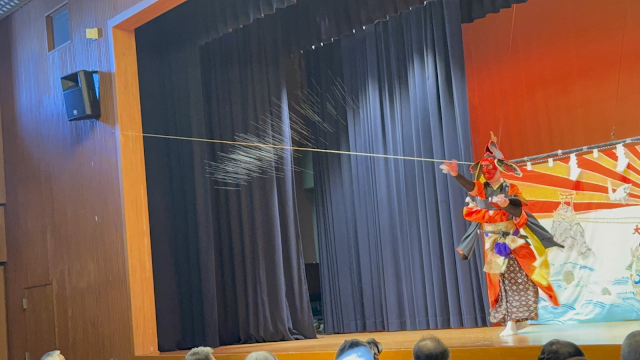Kuromori Kagura Kitakami Tour (February 22, 2025)
On February 22, Kuromori Kagura(黒森神楽) came to tour Kitakami City in Iwate Prefecture, so I went to see them! I first heard of Kuromori Kagura at last year's Miyako Folk Performing Arts Festival, and I was deeply moved when I saw them for the first time at that year’s Michinoku Folk Performing Arts Festival. I was truly delighted to have another opportunity to see them again.
What is Kuromori Kagura?
Kuromori Kagura was originally led by the betto (administrator) of Kuromori Shrine in Yamaguchi, Miyako City. It was passed down by a group of Shugendō Yamabushi (mountain ascetics) who used Kuromoriyama as their place of training. Today, it is inherited by volunteers from Miyako City, Iwaizumi Town, and Omoto, among other places.
There is a tradition of carrying the Gongen-sama (lion head) of Kuromori Shrine on a village tour. According to a document from Hōreki 8 (1758), "Miyako Kuromoriyama Shishimai Mawarikata Sanpeiisho-fu-chō," this village tour had already been taking place since before the Enpō era (1673–81), covering villages in the Noda, Miyako, and Ōtsuchi areas. The oldest recorded lion head among the current 22 dates back to Bunmei 17 (1485), suggesting that Kuromori Kagura originated in the mid-Muromachi period.
This kagura group is one of the few that continues the tradition of Shugendō kasumi (patron) visits through kagura tours. It holds highly significant ritual customs, such as Mai-komi (dedicatory dance), Mai-dachi (departure dance), Haka-shishi (grave lion dance), Hashira-kagari (pillar binding), Hi-fuse-kitō (fire prevention prayer), and Mi-gatame (body fortification). With its rich repertoire, Kuromori Kagura is of great historical value in performing arts.
Currently, they depart from Kuromori Shrine after the New Year, alternating each year between the northern route (Miyako City to Fudai Village) and the southern route (Miyako City to Ōtsuchi Town), touring for one to two months.
cited from Glossary of Iwate's Cultural Information
cited from Glossary of Iwate's Cultural Information
Program:
0:00 Kami-dashi & Mai-komi
14:09 Uchinara-shi
27:18 Iwato
39:25 Iwanaga-hime
55:38 Sanbamikagura
1:16:57 Ise Mairi
1:57:49 Yama no Kami Mai
2:27:46 Ebisu Mai
2:45:10 Mai-dachi
14:09 Uchinara-shi
27:18 Iwato
39:25 Iwanaga-hime
55:38 Sanbamikagura
1:16:57 Ise Mairi
1:57:49 Yama no Kami Mai
2:27:46 Ebisu Mai
2:45:10 Mai-dachi
This was not a stage performance but a "touring ritual," meaning the full event was conducted as a traditional ceremony from start to finish. It began at the entrance of Ezuriko District Exchange Center with Kami-dashi and Mai-komi.
At first, I noticed that the Gongen-sama (lion head) looked a little different, and it turned out to be the one owned by the Ezuriko District Center. At the end of the Mai-komi, there was a fire ritual where straw sandals (?) and small firewood were set aflame near the entrance of the center, and the Gongen-sama stomped them out. This was a fire prevention ritual.
The program listed "Normal Mai-komi" instead of "Shittogi Shishi," which is a 30-minute dance. Due to time constraints, they performed a regular Mai-komi instead of the Shittogi Shishi dance this time.
Afterward, the event moved to the hall, where Uchinara-shi was performed to invite the deities to the sacred seat, and the main performances began.
Many of the performances, such as Iwato, Sanban Gokagura (Old Opening), Iwanaga-hime (about Yamato Takeru), and Ebisu Mai (about Hiruko), were based on the same myths as some of the performances in Ogatsu Hōin Kagura, which I am familiar with. While watching, I naturally compared their similarities and differences.
The unexpected performance, "Ise Mairi," was a comedic skit featuring a Yamabushi on a pilgrimage to Kumano and a villager named Hachibei on his way to Ise. The story followed their humorous interactions and ended with them catching a thief, making for an entertaining experience.
"Yama no Kami Mai" is said to be the most important dance in Kuromori Kagura. The Mountain God of Kuromoriyama is a goddess, and her red face represents the strain of childbirth. The black sash on her back symbolizes carrying a child. The performance was powerful, and the act of scattering rice (?) around the hall felt both forceful and nurturing, as if sowing seeds of fortune.
At the end of all the performances, the final ritual dance, Mai-dachi, was performed, marking the departure of the Gongen-sama from its lodging. As the audience exited, purifying salt was scattered, and the Gongen-sama gave purification bites to those who wished.
Before leaving, I paid my respects to the shrine’s lion head and expressed my gratitude for the opportunity to witness this kagura.
Afterward, I checked into an inn in Kitakami City and headed to the folk performing arts-themed izakaya, Oni Kenbai.(To be continued...)
-----
Original Article(Japanese)
https://note.com/coupieyukki/n/n2b702993f722
-----
Original Article(Japanese)
https://note.com/coupieyukki/n/n2b702993f722














Comments
Post a Comment